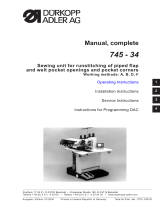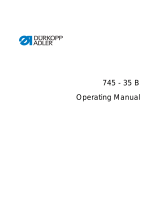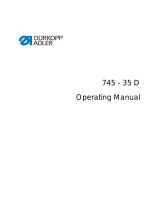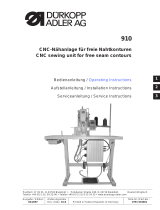Page is loading ...

Manual, complete
745 - 34 - 2
Sewing unit for runstitching of piped flap
and welt pocket openings and pocket corners
Working methods: A, B, D, F
Operating Instructions
Installation Instructions
Service Instructions
Instructions for Programming DAC
Postfach 17 03 51, D-33703 Bielefeld • Potsdamer Straße 190, D-33719 Bielefeld
Telefon + 49 (0) 5 21 / 9 25-00 • Telefax + 49 (0) 5 21 / 9 25 24 35 • www.duerkopp-adler.com
1
2
3
4
Ausgabe / Edition: Änderungsindex Teile-Nr./Part.-No.:
08/2007 Rev. index: 01.0 Printed in Federal Republic of Germany 0791 745181

745 - 34 - 2
Manual, complete
Contents
Operating Instructions
Installation Ins tructions
Service Instructions
Instructions for Programming DAC
Interconnection-diagram
9870 745154 B
9890 745002 B
Pneumatic circuit plan
9770 745005
All rights reserved.
Property of Dürkopp Adler AG and copyrighted. Reproduction or publication of the content in
any manner, even in extracts, without prior written permission of Dürkopp Adler AG, is
prohibited.
Copyright ©
Dürkopp Adler AG - 2007

Foreword
This instruction manual is intended to help the user to become familiar
with the machine and take advantage of its application possibilities in
accordance with the recommendations.
The instruction manual contains important information on how to
operate the machine securely, properly and economically. Observation
of the instructions eliminates danger, reduces costs for repair and
down-times, and increases the reliability and life of the machine.
The instruction manual is intended to complement existing national
accident prevention and environment protection regulations.
The instruction manual must always be available at the machine/sewing
unit.
The instruction manual must be read and applied by any person that is
authorized to work on the machine/sewing unit. This means:
– Operation, including equipping, troubleshooting during the work
cycle, removing of fabric waste,
– Service (maintenance, inspection, repair) and/or
– Transport.
The user also has to assure that only authorized personnel work on the
machine.
The user is obliged to check the machine at least once per shift for
apparent damages and to immediatly report any changes (including the
performance in service), which impair the safety.
The user company must ensure that the machine is only operated in
perfect working order.
Never remove or disable any safety devices.
If safety devices need to be removed for equipping, repairing or
maintaining, the safety devices must be remounted directly after
completion of the maintenance and repair work.
Unauthorized modification of the machine rules out liability of the
manufacturer for damage resulting from this.
Observe all safety and danger recommendations on the machine/unit!
The yellow-and-black striped surfaces designate permanend danger
areas, eg danger of squashing, cutting, shearing or collision.
Besides the recommendations in this instruction manual also observe
the general safety and accident prevention regulations!

General safety instructions
The non-observance of the following safety instructions can cause
bodily injuries or damages to the machine.
1. The machine must only be commissioned in full knowledge of the
instruction book and operated by persons with appropriate training.
2. Before putting into service also read the safety rules and
instructions of the motor supplier.
3. The machine must be used only for the purpose intended. Use of
the machine without the safety devices is not permitted. Observe all
the relevant safety regulations.
4. When gauge parts are exchanged (e.g. needle, presser foot, needle
plate, feed dog and bobbin) when threading, when the workplace is
left, and during service work, the machine must be disconnected
from the mains by switching off the master switch or disconnecting
the mains plug.
5. Daily servicing work must be carried out only by appropriately
trained persons.
6. Repairs, conversion and special maintenance work must only be
carried out by technicians or persons with appropriate training.
7. For service or repair work on pneumatic systems, disconnect the
machine from the compressed air supply system (max. 7-10 bar).
Before disconnecting, reduce the pressure of the maintenance unit.
Exceptions to this are only adjustments and functions checks made
by appropriately trained technicians.
8. Work on the electrical equipment must be carried out only by
electricians or appropriately trained persons.
9. Work on parts and systems under electric current is not permitted,
except as specified in regulations DIN VDE 0105.
10. Conversion or changes to the machine must be authorized by us
and made only in adherence to all safety regulations.
11. For repairs, only replacement parts approved by us must be used.
12. Commissioning of the sewing head is prohibited until such time as
the entire sewing unit is found to comply with EC directives.
13. The line cord should be equipped with a country-specific mains
plug. This work must be carried out by appropriately trained
technicians (see paragraph 8).
It is absolutely necessary to respect the safety
instructions marked by these signs.
Danger of bodily injuries !
Please note also the general safety instructions.

1
Index Page:
Part 1: Operating Instructions 745-34-2
(Edition 08/2007)
1. Product Description
1.1 Description of proper use........................................ 5
1.2 Briefdescription............................................. 5
1.3 Technicaldata .............................................. 7
1.4 Optional equipment ........................................... 8
2. Operation
2.1 Swingingthefoldingstationaside................................... 11
2.2 Pushing the covering hood back and removing the fabric sliding sheet ............ 12
2.3 Tilting the machine head up ...................................... 15
2.4 Needles and threads .......................................... 16
2.5 Threading the needle thread ...................................... 19
2.6 Winding the hook thread ........................................ 20
2.7 Remainingthreadmonitor....................................... 21
2.8 Changing the bobbins .......................................... 22
2.9 Threadtension.............................................. 24
2.10 Stackingcontrol ............................................. 25
2.11 Slantedpocketcorners......................................... 26
2.11.1 Swingingthecornerknifestationout/in .............................. 27
2.11.2 Setting the corner knives (Manual corner knife station)...................... 28
2.12 Referenceposition-Startingthesewingcycle-Quickstop................... 30
2.13 Flapandpipingprojection....................................... 31
2.14 Piping strip length ............................................ 32
2.15 Working methods ............................................. 33
2.15.1 Working method A (Production of trousers) ............................. 34
2.15.2 Sewingwithflap............................................. 37
2.15.2.1 Sewing without light barrier ...................................... 37
2.15.2.2 Sewingwithlightbarrier ........................................ 39
2.15.3 Working method A (Production of jackets)
Piped pockets, manual positioning of piping strip, flaps and other additional parts ..... 40
2.15.4 Working method B
Piped pockets, automatic feed of the piping strip, without/with incision of the
piping ends ................................................ 46
2.15.5 Working method D
Breastweltpockets,automaticfeedandmatchingofthebreastwelt ............. 56
2.15.6 Working method F
Piped pockets, automatic feed of the piping strip,
incision of the piping ends, matching and feed of the flap .................... 62
2.15.7 Foldermonitoring ............................................ 66
2.16 Functions and operation of the optional equipment ........................ 67
2.16.1 Automatic incision device for piping ends .............................. 67
2.16.2 Downholder, pocket bag and waistband clamp ........................... 70
2.16.3 Feeding devices for flaps, pocket bags etc.............................. 71

Index Page:
2.16.4 Throw-overstacker ........................................... 72
2.16.5 Roll-offdevice .............................................. 74
2.16.6 Blow-outdevice ............................................. 75
2.16.7 Bundle clamp and roll-off device ................................... 76
2.16.8 Tapefeedandautomaticcutting.................................... 77
2.16.9 Endless zipper device.......................................... 81
2.16.10 Vacuumdevice.............................................. 82
2.16.11 WorkingmethodBwithsetofparts“Pocketbagonflap” .................... 83
2.16.12 Zipper feeders for method B ...................................... 86
2.16.13 Set of parts “Shaped guide Lining loop triangle” for 745-34-2 methods B and F ....... 87
2.16.14 Smoother for 745-34-2 A and B .................................... 88
3. Maintenance
3.1 Cleaning .................................................. 89
3.2 Weeklylubrication............................................ 92

1. Product description
1.1 Description of proper use
The 745-34-2 is a sewing unit which can properly be used for sewing
light to medium-weight material. Such material is, as a rule, material
made of textile fibres or leather. These materials are used in the
garment industry.
In general only dry material should be sewn on this machine. The
material must not contain any hard objects.
The seam is generally made with core thread, polyester fibre
or cotton threads.
The dimensions for needle and hook threads can be taken from the
table in c hapter 2.4.
Before using any other threads it is necessary to estimate the
consequential dangers and to take the respective safety measures, if
required.
This sewing unit must only be installed and operated in dry and
well-kept rooms. If the sewing unit is used in other rooms, which are
not dry and well-kept, further measures to be agreed upon may
become necessary (see EN 60204-31 : 1999).
We, as a manufacturer of industrial sewing machines, assume that at
least semi-skilled operating personnel will be working on our products
so that all usual operations and, where applicable, their risks are
presumed to be known.
1.2 Brief description
The Dürkopp Adler 745-34-2 is a sewing unit for automatic
runstitching of piped, flap and welt pocket openings with rectangular or
slanted pocket corners.
The slanted pocket corners result from the seam offset of the two seam
rows. At the seam beginning and seam end it is possible to sew with
different slants.
Dependent on the working method different feeding devices, corner
knife stations and optional equipment are used.
Machine head
–
Twin needle lockstitch version
–
Needle bars can be switched separately or together
–
Large vertical hooks
–
Externally driven center knife, speed and circuit timing
programmable
–
Thread trimming device for needle and hook threads
–
Needle thread monitor
–
Photoelectric remaining thread monitor for the hook threads
–
Sewing drive as DC d irect drive
1
5

Step motors for t he material feed and the length adjustment of the
corner cutting device
The step motor technology results in short machine times and
guarantees an absolutely precise corner incision.
Thus, it contributes to a pocket quality as yet unequalled and combined
with high productivity.
New generation of “DAC III” controls (DÜRKOPP ADLER Control)
The graphic user guidance exclusively occurs via internationally
comprehensible symbols and text lines in the corresponding language.
The various symbols are combined in groups within the menu structure
of the sewing and test programs.
The ease of use makes short training times possible.
The user can combine 99 freely programmable pocket programs with
up to 20 seam patterns.
20 pocket sequences can be called up.
Every pocket sequence can be combined of up to 8 pocket programs in
any order whatever.
All slants suitable for practical application can be programmed by the
operator at the touch of a button.
The time-consuming adjustment of the corner knives and the tiresome
programming of seam offsets are not required.
The comprehensive test and monitoring system MULTITEST is
integrated in the DAC.
A microcomputer does the control tasks, monitors the s ewing cycle and
signals operating faults and malfunctions on the display.
Optional equipment
By means of a flexible system of optional equipment the sewing unit
can be equipped optimally and economically corresponding to the
respective application.
See chapter 1.4 (Equipment of the 745-34-2).
Sew ing equipment and folders
Data concerning the sewing equipment and folders for the various
applications can be taken from the Equipment Sheets of cl. 745-34-2.
Please direct your enquiries to the DÜRKOPP-ADLER sales offices.
6

1.3 Technical data
Machine head: Class 0246 992002
Needle system: 2134-85
Needle distance: 10, 12, 14, 16, 20, 24, 26, 30 mm
Needle size: Nm 80 to Nm110
Threads: see table chapter 2.4
Stitch type: Twin needle lockstitch
Speed: min. 2000 rpm
max. 3000 rpm
Stitch length: min. 2.0 to 3.0 mm
Number of stitches/condensed
stitches: 1 - 10 stitches
Number of stitches/bartack
stitch: 0 - 5 stitches
Stitch length condensed
stitches / bartack: 0.5 - 3.0 mm
Pocket length: max. 220 mm
Seam offset: max.
+
/- 13 mm
Operating pressure: 6 bar
Air consumption: approx. 6 NL per work cycle
Rated voltage: 3 x 230 / 400 V / 50/60 Hz
Rated load:
Machine with
vacuum blower 0,8 KW
Machine without
vacuum blower 0,5 KW
Dimensions: 1540 x 925 x 1200 mm (L x W x H)
Working height: 790...1100 mm
(upper edge of table top)
Weight: 280 kg
Rated noise level: LC = 81 dB (A)
Workstation-specific emission value
according to DIN 45635-48-B-1
Stitch length: 2.5 mm
Seam length: 180 mm
Speed: 2750 rpm
Material: double fabric
240 g/m
2
Measuring point according to DIN
4895 Part 1
X = 600 mm Y = 0 mm Z = 300 mm
7
1

1.4 Optional equipment
Order No. Optional equipment A B D F
0745 597514 Downholder- pocket bag clamp
Downholder for smoothing the fullness
caused by darts as well as a
clamping device for pocket bags
XX
0745 597524 Waistband clamp
For smoothing the fullness.
Only possible in conjunction with 0745 597514
XX
0745 597544 Endless zipper
Scissors with roll-off device for endless zippers
without slider
X
0745 597554 Throw-over stacker
To be positioned near the machine for stacking to the
side or to the back.
Furthermore, this throw-over stacker is equipped with
an easy-to-operate height adjustment and
a swivel device.
XXXX
0745 597604 Blow-out device
For blowing the finished workpieces out
XX
0745 597614 Shaped guide “Lining loop triangle”
In case of inside pockets the lining loop triangle
is fed automatically.
XX
0745 597674 Table extension (large)
The table extension required for the working method
with bundle clamp carriage
X
0745 597684 Table extension (small)
Tableextensiontobeusedforstackingtotheside
XXXX
0745 597694 Bundle clamp
This includes the required large table extension
XX
0745 597764 Right zipper feeder
In conjunction with feeding device 0745 517574
For cut-to-length zippers,
without slider, total width 24 mm, chain width
approx. 4 mm, in case of ready-made pocket chain
inside.
X
0745 597774 Left zipper feeder
In conjunction with feeding device 0745 517564
For cut-to-length zippers,
without slider, total width 24 mm, chain width
approx. 4 mm, in case of ready-made pocket chain
inside.
X
0745 597784 Right zipper feeder
In conjunction with feeding device 0745 517574
For cut-to-length zippers,
without slider, total width 24 mm, chain width
approx. 4 mm, in case of ready-made pocket chain
inside.
X
0745 597794 Left zipper feeder
In conjunction with feeding device 0745 517564
For cut-to-length zippers,
without slider, total width 24 mm, chain width
approx. 4 mm, in case of ready-made pockets chain
inside.
X
8

Order No. Optional equipment A B D F
0745 597824 Smoother for the 745-34-2 A/B
The smoother has the purpose to s mooth the finished
workpiece held by the bundle clamp. Only in
combination with the table extension 0745 597674
and the roll-off device 0745 597954.
XX
0745 597874 Set of parts “Pocket bag on flap” NA 10 and 12
for the simultaneous attaching of two pocket bag
halves and flap. Combination only in conjunction with
equipment E 3103 or E 3503 for NA 10
as well as E 3107 or E 3507 for NA 12.
X
0745 597884 Set of parts “Pocket bag / Piped pocket”
for the blowing of the pocket bag or the piping pocket
with equipment E 2604 or E 2606.
Use only in combination with the clamp K19.
X
0745 597934 Three-pack lasers
Add-on kit: for expanding the existing 5 laser marking
lamps to a maximum of 8 laser marking lamps.
(With the working method F, the s tandard equipment
includes 8 laser marking lamps).
XXXX
0745 597944 Electromotoric tape feed/Automatic cutting
Automatic feeding and cutting of a
reinforcement strip pulled from a roll. Start time and
cutting time can be programmed
corresponding to the pocket.
XXXX
0745 597954 Roll-off device
It is used to for transporting short pieces into the
stacker or to eject the pieces to be processed.
The speed and the working cycle of the roll-off device
can also be programmed.
XXXX
0745 597964 Vacuum (side channel compressor)
For an accurate positioning of the material when
no in-house vacuum unit is available.
The side channel compressor can be used with the
basic unit.
XXXX
0797 003031 Pneumatic connection package
Connection hose to the pneumatic supply line
with the appropriate couplings.
XXXX
0745 517564 Automatic feeding, left 180 - 220 mm
For the automatic feeding of piping strips and
additional parts.
X
0745 517574 Automatic feeding, right 180 - 220 mm
For the automatic feeding of piping strips and
additional parts.
X
0745 598054 Kit second light barrier
X
1
9

10
1
2

2. Operation
2.1 Swinging the folding station aside
For operations at the sewing point (threading the needle threads,
needle change etc.) the whole folding station with folder and light
barriers can be swung to the right.
–
Swing the complete folding station 1 with folder
to the right.
Note:
With the sewing unit switched on, a safety message
appears on the screen of the control panel.
Folding station swung out
–
The sewing point is freely accessible.
Sw inging the folding station back
–
Swing the folding station back.
ATTENTION!
After being swung back the folding station must lock
in the catch 2.
1
11

2.2 Pushing the covering hood back and removing the fabric sliding sheets
Caution: Danger of injury!
Switchthemainswitchoff.
Push the covering hood back and remove the fabric sliding sheet only
with the sewing unit switched off.
–
Switchthemainswitchoff
For a better accessibility of the feeding clamps the covering hood can
simply be displaced.
Pushing the covering hood back
–
Push the covering hood 1 to the left.
The feeding clamps are accessible.
–
Push the covering hood 1 to the right again until you hear it
snapping in.
12
1

For changing the hook thread bobbins:
–
Lift the fabric sliding sheet 2 in the area of pin 1 and swing it to the
left.
For a complete removal (for maintenance and adjusting operations):
–
Lift off the fabric sliding sheets at the pin 3.
1
13
21
3

14
13
6
45

2.3 Tilting the machine head up
For maintenance work the machine head can be tilted up.
For this purpose the transport carriage must be in its rear end position.
Caution: Danger of injury!
Switchthemainswitchoff.
Tilting the machine head up.
–
Remove the covering hood 1.
For this purpose lift the covering hood at the front so that the catch
is released. Carefully lift the covering hood upwards.
–
Swing the folding station 3 out by 90°.
–
Swivel the locking lever 4 up.
–
Lift the left fabric sliding sheet 6 at the front and swing it to the left.
–
Lift the machine head in the area of head cover 5 and tilt it up
carefully.
Pawl 2 snaps in additionally.
The space under the machine table is accessible for cleaning now.
Sw inging the machine head back
–
Hold the machine head tight in the area of head cover 5.
–
Release the pawl 2.
–
Swing the machine head back carefully.
Caution: Danger of breakage!
Hold the machine head tight until it is at rest completely.
–
Insert the fabric sliding sheets.
–
Swivel the locking lever 4 down.
–
Swing the folding station 3 back and let it catch with the locking
lever.
–
Put on the covering hood 1 and let it catch again.
1
15
2

2.4 Needles and threads
Needle system: 2134-85
Recommended
needle size: Nm 90 for thin material
Nm 100 for medium-weight material
Nm 110 for heavy-weight material
High sewing security and good sewability are achieved with the
following core threads:
–
Two-ply polyester endless polyester core-spun
(e.g. Epic Poly-Poly, R asant x, Saba C, ...)
–
Two-ply polyester endless c otton core-spun
(e.g. Frikka, Koban, Rasant, ...)
If these threads are not available, the polyester fibre or cotton threads
listed in the table c an also be sewn.
Often two-ply core threads are offered by the thread manufacturers
with the same designation as three-ply polyester fibre threads
(3cyl.-spun).This causes uncertainty with regard to twisting and thread
thickness.
When in doubt, unravel the thread and check w hether it is twisted 2- or
3-ply.
The label no. 120 on the thread reel of a core thread corresponds e.g.
to the thread size Nm 80/2 (see table values in brackets).
In case of monofilament threads you can use needle threads and hook
threads of the same thickness. The best results are achieved with soft
and elastic threads (software) of the thread thickness 130 Denier.
Recommended thread sizes:
Needle size Core thread Core thread
Nm
Needle thread Hook thread Needle thread Hook thread
Polyester Polyester Polyester Cotton
endless core-spun endless core-spun
Label No. Label No. Label No. Label No.
90 120 (Nm 80/2) 120 (Nm 80/2) 120 (Nm 80/2) 120 (Nm 80/2)
100 100 (Nm 65/2) 100 (Nm 65/2) 100 (Nm 65/2) 100 (Nm 65/2)
110 75 (Nm 50/2) 75 (Nm 50/2) 75 (Nm 50/2) 75 (Nm 50/2)
Needle size Polyester fibre thread Cotton thread
Nm (3cyl.-spun)
Needle thread Hook thread Needle thread Hook thread
90 Nm 80/3-120/3 Nm 80/3-120/3 Ne
B
50/3-70/3 Ne
B
50/3-70/3
100 Nm 70/3-100/3 Nm 70/3-100/3 Ne
B
40/3-60/3 Ne
B
40/3-60/3
110 Nm 50/3-80/3 Nm 50/3-80/3 Ne
B
40/4-60/4 Ne
B
40/4-60/4
16

Changing the needles
Caution: Danger of injury!
Switchthemainswitchoff.
Change the needles only with the main switch switched off.
Risk of injuries from cuts!
Do not reach into the area of the center knife 3 when changing the
needles.
–
Swing the folding station aside (see chapter 2.1)
The needles are freely accessible.
–
Loosen screw 2 and remove the needle from the needle holder 1.
–
Push the new needle into the drill-hole of the needle holder 1 as far
as it will go.
ATTENTION!
Seen from the operator ’s side the hollow groove 4 of the left needle
must point to the left and the hollow groove 5 of the right needle
must point to the right (see sketch).
–
Tighten screw 2.
ATTENTION!
After c hanging to another needle size the needle protection on the
hook has to be readjusted (see Service Instructions).
Note:
The standard needle size of class 745-34-2 is Nm 100.
1
17
1
2
3
4
5

18
3
4
5
6
7
8
9
10
12 11
17
16
15
14
21
2
/












